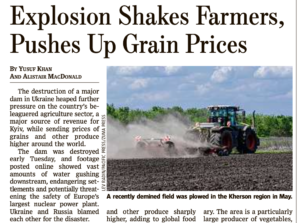Bloomberg's Clarice Couto reported this past Friday that "a surprising tax change in agriculture powerhouse Brazil has the potential to make soy grown in the world’s largest bean exporter less…
China Imported Record Amount of Soybeans in May; Ukraine Dam Explosion Ag Impacts Unfold
Reuters writer Dominique Patton reported yesterday that, “China imported a record 12.02 million tonnes of soybeans in May, up 24% on a year ago, Reuters calculations based on customs data showed, as cargoes delayed during last month’s strict inspections were finally unloaded at ports.
Soybean arrivals for the first five months of the year reached 42.31 million tonnes, up 11.2% year-on-year, the General Administration of Customs said on Wednesday.
And Bloomberg News reported today that, “China posted robust commodities imports in May, defying stutters in the wider economy, as buyers took advantage of weaker international prices and energy importers stocked up ahead of peak demand in the summer.”
“Soybean imports hit a record after some cargoes stuck at ports due to tighter inspections finally cleared customs,” the article said.
Today’s article added that, “Edible oils fell from the previous month, but have still more than doubled over the year-to-date as catering and restaurant demand recovers after the pandemic.”
With respect to China’s wheat production, Reuters writers Qin Ningwei and Josh Arslan reported today that, “After two weeks of continuous heavy rains, a farmer surnamed Chen in China’s Henan province surveys bent stalks of saturated wheat in sodden fields that will take days to dry out before harvesting can start.
“The rains are also causing the kernels on his wheat crop to begin sprouting early, which, more crucially, means the grain will produce lower quality flour unsuitable for noodles or bread. That could mean a large chunk of the crop will end up being sold as less valuable animal feed, or even abandoned.”
The article explained that, “About one-third of China’s wheat is grown in Henan province, earning it the nickname the granary of China. With roughly 30 million metric tons expected to be affected nationally by the rains, out of a forecast bumper crop for all of China of 137 million metric tons, the losses may mean rising grain imports into the world’s biggest wheat consumer.”

Also today, Bloomberg News reported that, “Sweltering temperatures across China are killing livestock and stretching power grids, an early heat wave that portends another summer of disruption for Asia’s industry and food supply.”
The article noted that, “The scorching weather is proving particularly dangerous to animals. Hundreds of pigs have been dying in Jiangsu province and farmed fish perished as water temperatures soared in Guangxi, according to reports in local media.”
More broadly regarding China, Demetri Sevastopulo reported today at the Financial Times Online that, “US secretary of state Antony Blinken will travel to China this month, in the latest sign that Beijing and Washington are beginning to stabilise a turbulent bilateral relationship that had sunk to the lowest point in decades.”

Meanwhile, Yusuf Khan and Alistair MacDonald reported in today’s Wall Street Journal that, “The destruction of a major dam in Ukraine on Tuesday heaped further pressure on the country’s beleaguered agriculture sector, a major source of revenue for Kyiv, while sending prices of grains and other produce higher around the world.”
The article stated that, “Ukraine is responsible for a large chunk of global agricultural exports and Russia’s 2022 invasion sent prices of grains and other produce sharply higher, adding to global food inflation and worsening food shortages in some developing countries. Agriculture also represents more than half of Ukraine’s export revenue, which Kyiv depends on to help finance its fightback against Russia’s invasion.
“Wheat futures on Tuesday rose 3.7% in thin morning trading before falling back slightly, while corn futures increased 1.6%.
“As irrigation canals drained and waters continued to wash over farmland, many farmers and food producers were still waiting to discover the damage to their land and crops, particularly those with property in occupied parts of the country that are difficult to access.”
Khan and MacDonald added that, “Ukraine’s farming industry has been hit hard by Russia’s invasion. Equipment has been destroyed, land expropriated and mined and export routes choked off. Financing is hard to come by, and some of the industry’s most basic imports, such as fertilizer, are in short supply due to the effects of the war.
“A deal to allow the export of Ukrainian grain via the Black Sea, after a Russian blockade at the start of the invasion, was extended last month until mid-July, but question marks remain over its long-term viability.
“Russia has threatened to pull out multiple times. Farmers in some Eastern European countries have secured temporary bans on Ukrainian grain sales, saying that prices have plunged in local markets as a result of increased exports from Ukraine overland.”
Reuters writer Pavel Polityuk reported today that, “The destruction of the Kakhovka dam will flood tens of thousands of hectares of agricultural land in southern Ukraine and could turn at least 500,000 hectares of land left without irrigation into ‘deserts,’ the agriculture ministry said.”
“The ministry has not said how much grain could be lost because of flooding,” the Reuters article said.
Dow Jones writer Kirk Maltais reported yesterday that, “Exports of wheat out of Russia are expected to exceed last year’s record, said SovEcon in a note. The agricultural research firm says that exports in the 2023/24 marketing year are expected to beat the previous year by 3%, totaling 45.7 million metric tons. The firm says that higher production of wheat, totaling 88 million tons, is the primary driver for higher exports.”

And Reuters writer Naveen Thukral reported today that, “Chicago wheat futures ticked higher on Wednesday, underpinned by concerns over Black Sea supplies and lower output in Australia, although a lack of demand for U.S. cargoes kept prices below the previous session’s near three-week high.
“Soybeans and corn firmed, as dryness for newly planted crops in the U.S. Midwest threatened yields.”







